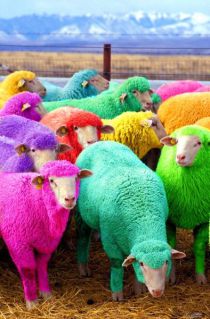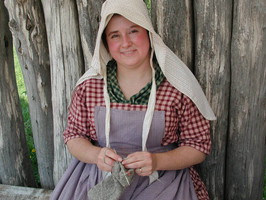
"Colored" or "Black" Sheep
 An edited photo of sheep. They are not born this way! (Thanks to all of my facebook friends who sent me this photo! If anyone knows the name of the artist please let me know so I can properly credit him/her.)
An edited photo of sheep. They are not born this way! (Thanks to all of my facebook friends who sent me this photo! If anyone knows the name of the artist please let me know so I can properly credit him/her.)
Are There Really Pink and Blue Sheep?
In shepherding terms, a “white” sheep is white, but a “colored” or “black” sheep is any sheep that is not completely white. The words colored and black are used interchangeably and could
mean a sheep that is black, gray or brown, or even a mostly white sheep with just a spot of black, gray or brown.
Natural dyes created with plants, flowers and berries can dye white wool just about any color in the rainbow, but dark wool is difficult to dye with natural dyes. Because of this, for most of
history white wool brought higher prices than dark wool and most farmers didn’t want sheep that were anything but solid white.
Aniline dyes (a chemical dye derived from coal tar) were invented in the 1830s, and colored wool can be beautifully died with chemical dyes. But even today, a dealer buying a bag of white wool
has to be assured that it is completely white. Colored sheep need to be separated from the flock and sheared separately on shearing day, so most modern farmers still prefer white sheep.
In "The Workwoman’s Guide, By A Lady" (1838) the author notes in her pattern for a knit armlet that “fine black lamb’s wool is most usually worn, in which case, it should be well steeped in
vinegar, and then dried, to prevent the dye from coming off.” She is not referring to the naturally black wool of black lambs, but white wool that has been dyed black. Black wool looks
the same as white wool dyed black, and in fact would be better because there would be no fear of the dye fading or running. The author’s directions suggest that white wool dyed black was more
commonly available in the 1830s than naturally black wool.
Your project will determine what color wool you use. The softness of wool is determined by how thick or thin an individual strand of wool is. Just as blonde people have finer, softer hair
than brunettes, white sheep have thinner, softer individual strands of wool than colored sheep. Naturally colored wool works well for socks, mittens, sweaters, etc., - but don't use it to knit
underwear!
If you’re interpreting a period before the invention of chemical dyes in the 1830s and you plan to dye your wool with natural dyes, it would be more historically correct to dye over white wool.
This doesn’t mean that colored wool was never dyed before the 1830s – it certainly could have been – but white wool was preferred for dying.
If your goal is to represent a time period after the 1830s and you plan to dye with chemical dyes, then you would be accurate using either white or colored wool, although keep in mind that white wool
will give you a brighter, bolder color than dying gray wool. Note that my brown wool won't dye at all, it's just too dark, but my gray wool will give a very pretty subdued, heathered look when
dyed.
For any time period, natural, undyed wool (white or colored) is always correct.
The Black Sheep of the Family
Color in sheep is a genetically recessive trait, so it is possible for a white ewe and a white ram to produce a colored lamb. This is where our notion of there being a black sheep in every family comes from. Even a “good” family (whether a sheep or human family) will sometimes produce an undesirable “black sheep.” In the 18th and 19th century a colored lamb would be raised for the dinner table, but would probably not be kept for next year’s breeding cycle.
If you don't think your family has a "black sheep," then you may be the black sheep!


